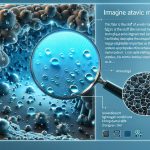Are you ready to experience the fabric revolution?
Discover how modern advances in textile technology are transforming the way we wear and interact with fabrics.
From sustainable materials to smart textiles, nanotechnology to 3D printing, and advanced dyeing techniques, this article will explore the cutting-edge innovations that are reshaping the textile industry.
Get ready to be amazed by the endless possibilities and endless comfort of the fabrics of the future.
Table of Contents
Sustainable Fabrics
In the world of textile technology, you can contribute to a greener future by embracing sustainable fabrics. One way to do this is by adopting the principles of the circular economy in textile production. The circular economy aims to minimize waste and maximize resource efficiency by reusing and recycling materials. In the textile industry, this means finding innovative ways to repurpose and regenerate fabrics.
One of the key elements of sustainable fabrics is the use of eco-friendly fabric innovations. These innovations focus on reducing the environmental impact of textile production and consumption. For example, there are now fabrics made from recycled materials such as plastic bottles or discarded garments. These fabrics not only reduce waste but also require less energy and water to produce.
Another eco-friendly fabric innovation is the use of natural fibers such as organic cotton, hemp, and bamboo. These fibers are grown without the use of harmful pesticides and fertilizers, making them better for the environment and for the people who work with them.
Smart Textiles
Explore the endless possibilities of smart textiles and discover how they can enhance your everyday life. With the integration of wearable technology and interactive fabrics, the future of fashion and functionality is revolutionized.
Here are four remarkable ways smart textiles can transform your world:
-
Health Monitoring: Imagine wearing a shirt that tracks your heart rate, body temperature, and even detects potential health issues. Smart textiles have the potential to revolutionize healthcare by providing real-time data, allowing for early detection and prevention of illnesses.
-
Safety Enhancement: Smart textiles can be embedded with sensors that detect changes in the environment, such as toxic gases or radiation levels. These fabrics can alert you to potential dangers, ensuring your safety in hazardous situations.
-
Fashion Innovation: Say goodbye to static designs and hello to dynamic fashion. Interactive fabrics can change colors, patterns, and textures with a simple touch or gesture, allowing you to express your style in a whole new way.
-
Convenience and Connectivity: Smart textiles can seamlessly integrate technology into your everyday clothing, such as built-in speakers or phone charging capabilities. Stay connected and enjoy the convenience of having your devices always at hand.
The possibilities are endless with smart textiles. Embrace the future and experience the incredible benefits they offer in enhancing your everyday life.
Nanotechnology in Textiles
With the integration of nanotechnology, your clothing becomes more than just fabric – it becomes a powerful tool for enhancing performance and functionality. Nanotechnology involves manipulating materials at the nanoscale, which is one billionth of a meter. This technology has revolutionized the textile industry, leading to the development of innovative fabrics with incredible properties.
One of the remarkable applications of nanotechnology in textiles is the production of nanofibers. These fibers have a diameter of less than 100 nanometers and offer exceptional strength and durability. Nanofiber fabrics are being used in various fields, including healthcare, aerospace, and sportswear. They provide superior breathability and moisture-wicking capabilities, keeping you cool and comfortable during physical activities.
Another exciting advancement is the creation of self-cleaning fabrics. By incorporating nanoscale particles with photocatalytic properties, textiles can break down dirt and stains when exposed to light. These fabrics have a hydrophobic coating that repels liquids, preventing stains from setting. Say goodbye to the hassle of washing and treating stubborn stains, as your clothes will naturally stay clean and fresh.
Innovation in nanotechnology has opened up endless possibilities for the textile industry. From nanofiber applications to self-cleaning fabrics, these advancements are revolutionizing the way we think about clothing. Embrace the power of nanotechnology and experience the future of textiles.
3D Printing in Textile Manufacturing
Discover the game-changing capabilities of 3D printing in revolutionizing textile manufacturing. This innovative technology, also known as additive manufacturing, is transforming the way textiles are designed and produced.
Here are four reasons why digital printing is a game-changer in the textile industry:
-
Endless design possibilities: With 3D printing, you can create intricate and complex patterns that were previously impossible to achieve using traditional textile manufacturing methods. This opens up a world of creativity and allows designers to push the boundaries of textile innovation.
-
Reduced waste: Traditional textile manufacturing often results in significant material waste. However, with 3D printing, materials are used more efficiently, minimizing waste and reducing the environmental impact of textile production.
-
Customization and personalization: Digital printing allows for the creation of unique, one-of-a-kind textiles tailored to individual preferences. Whether it’s a custom-fit garment or a personalized home decor item, 3D printing enables greater personalization in textile manufacturing.
-
Faster production times: The speed of 3D printing technology allows for faster production times compared to traditional methods. This means that designers can bring their creations to market more quickly, meeting consumer demand in a timely manner.
Digital printing is revolutionizing the textile industry, offering endless design possibilities, reducing waste, enabling customization, and speeding up production. With 3D printing, the future of textile manufacturing has never looked more exciting.
Advanced Dyeing and Printing Techniques
Utilize advanced dyeing and printing techniques to enhance the vibrancy and durability of your textiles. One such technique that has revolutionized the industry is digital fabric printing. This innovative method allows for the creation of intricate and detailed designs that were once impossible to achieve with traditional printing methods. Digital fabric printing uses computer-controlled machines to apply dyes directly onto the fabric, resulting in vibrant colors and sharp patterns. Not only does this technique offer endless design possibilities, but it also reduces waste and minimizes the use of water and chemicals.
Another important aspect of modern dyeing and printing techniques is the focus on eco-friendly practices. With increasing concerns about the environmental impact of textile manufacturing, many companies are adopting sustainable dyeing techniques. These methods use natural and biodegradable dyes, as well as low-impact dyes that have minimal harm on the environment. Additionally, waterless dyeing processes are being developed to conserve water resources.
Frequently Asked Questions
How Do Sustainable Fabrics Impact the Overall Carbon Footprint of the Textile Industry?
Sustainable fabrics can reduce the carbon footprint of the textile industry by promoting a circular economy. By using recycled materials and minimizing waste, these fabrics educate consumers about their carbon footprint and encourage more environmentally-conscious choices.
What Are the Potential Health Risks Associated With Wearing Smart Textiles?
Wearing smart textiles may pose potential health risks due to the manufacturing processes involved. It’s important to be aware of any chemicals or allergens used in the production of these fabrics to ensure your well-being.
Can Nanotechnology in Textiles Pose Any Environmental Risks?
Nanotechnology in textiles can potentially pose environmental risks. Regulation and safety are important in addressing these concerns. It is crucial to monitor and manage the use of nanomaterials in textile production to minimize any negative impact on the environment.
How Does 3D Printing in Textile Manufacturing Affect the Quality and Durability of the Final Product?
When you use 3D printing in textile manufacturing, it can enhance the quality and durability of the final product by creating innovative textile structures that are strong and long-lasting.
Are Advanced Dyeing and Printing Techniques More Expensive Than Traditional Methods?
Advanced dyeing and printing techniques may be more expensive than traditional methods, but they offer innovative ways to enhance the quality and design of textiles. Consider the cost comparison and the added value they bring to the final product.
- Tetron Fabric for Marine Applications: Durability and Use Cases - June 18, 2025
- Tetron Fabric for Outdoor Furniture: Weather Resistance and Care - June 18, 2025
- Tetron Fabric for Wall Coverings: Style and Application Tips - June 18, 2025




